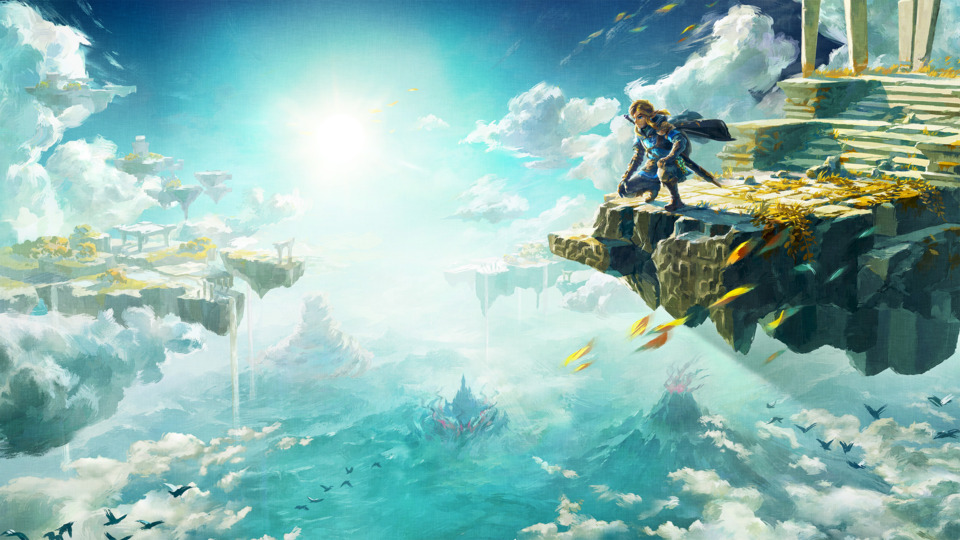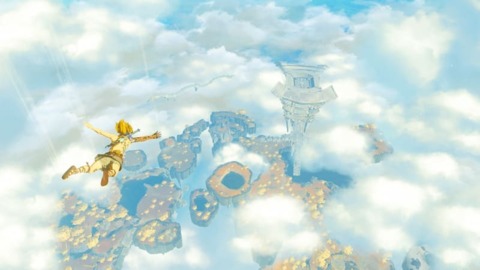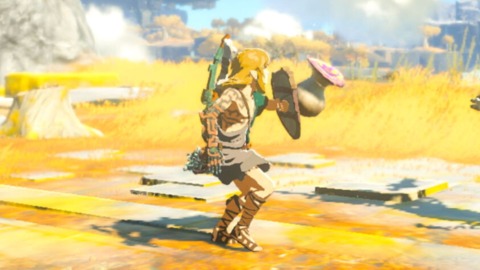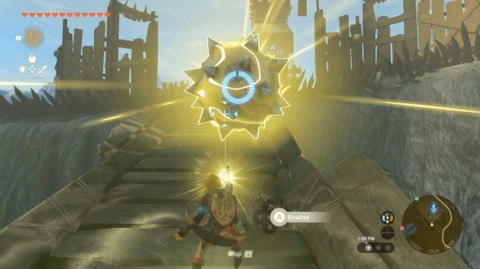Is Tears of the Kingdom a Good Sequel? A Comparative Review
By jeremyf 7 Comments
DISCLAIMER: This post does not contain any story spoilers outside of a dedicated spoiler block, which even then is not specific. However, this is unfortunately one of those games where it’s best to keep as many surprises for yourself as possible, and I will write in detail about mechanics and structure that is best discovered on your own.
Also, this post is based on a 50-hour playthrough where I completed the full main quest line and beat the game. However, there are still dozens, if not hundreds, of hours of content I did not see. It is possible that some of that content contradicts or recontextualizes an argument made here, but I am only drawing from my own experience for this one.

The Legend of Zelda: Breath of the Wild released close to the time I started my quasi-regular gaming blog on this site. Considering the flippant way I threw out takes back then, I’m thankful I never tried to review the game when it was new. The closest I came was a two-sentence aside in my top 10 list, where I said that I liked the game but Wind Waker was better. I replayed Breath of the Wild last year, and my opinions didn’t change very much. BotW did some incredibly novel things for the open world genre, but major design decisions limited my incentive to fully engage with every system. It barely cracked my top five in 2017, and every time I’ve since heard it claimed as the literal best game ever made, I raise at least one and a half eyebrows.
I’ve also noticed a worrying trend in the past few years with big-budget sequels to popular games. Namely, that the developers do next to nothing to fix the most glaring flaws with the previous entry. God of War’s overreliance on gearscore? Horizon’s unsympathetic characters? Fallen Order’s janky behavior? All problems that look even worse in the sequels which I, to be fair, have yet to touch. I get it, building out teams to create all these complex mechanics is difficult. But the lack of flexibility in AAA iteration is killing the opportunity for creativity.
So when I saw that Tears of the Kingdom would carry over BotW’s characters, world, gameplay loop, music, and even UI… yeah, I was worried that everything I found lacking in the previous game would come back as well. However, I wanted to make that judgment for myself. I avoided as much information as I could, which meant skipping trailers and clicking off any online theorizing. Shortly before release, I scribbled a list of BotW’s most glaring problems, with plans to judge TotK against those standards. That’s the purpose of this post. I’ve transcribed the list below to spare you my handwriting, but I was really tired when I wrote it, so it may not make sense regardless.
Bad Things in Breath of the Wild:
- Boring “past tense” story
- Truly godawful voice acting
- No incentive for combat with breakable weapons
- Holding forward and looking at a green circle
- Generic shrines/dungeons
- Climbing in rain (not really)
- Not using the Wii U GamePad!!
I’ll explain what I meant by each of these points in turn. Overall, if our sole definition of a good sequel is how well these problems are fixed, things get murky. Nothing on that list was totally excised from Tears of the Kingdom. However, every single one was addressed in some way that unilaterally makes the game better. TotK accomplishes this in two ways: First, by layering an open world denser than I have ever experienced before and making every inch worthwhile to see. Second, by opening the possibility space so wide that the world becomes a true playground for the most creative players. To accomplish these goals so well simultaneously is nothing short of jaw-dropping, and the result is a game with flaws that are far less irritable than before. Nintendo has fully supplanted Breath of the Wild, a game which I can never imagine playing again.
So by that measure, TotK is an amazing sequel. But if your definition of a good sequel includes building on the plot of the original, well… you may be disappointed.
The story structure of TotK is much the same as BotW, but executed better. There’s a bad guy at the castle, four towns on the map corners to investigate, and flashback sequences dotted throughout the world. From my notes, I clearly wasn’t invested in the memory sequences in BotW. Here, I actually like them. Yes, the events are taking place in the past, but they drive the plot of the present forward instead of reiterating information the player already knows. Whereas the BotW memories were often just things happening, the TotK story has things like twists, setup, and payoff. The game won’t be nominated for best narrative, but there is a good effort that I appreciate as someone who found the near-total absence of story in BotW maddening. Following up with the various returning characters was nice, too, even if their individual stories were still basic.

TotK’s English voice direction is no longer what I would call “embarrassing,” but it is still “bad.” The actors are willing to put in up to 15% emotion this time. I was most disappointed by Ganondorf, who deserves a chilling vocal performance but doesn’t surpass standard angry bad guy energy. That criticism applies to the character’s usage as a whole. I love his design in this game, which looks like a young version of Wind Waker’s middle-aged incarnation. Unlike in Wind Waker, though, there’s never an attempt to give him pathos. This Ganondorf relies on brute force first and foremost, only rarely resorting to obvious schemes that only work because most people in Hyrule are stupid. I understand that some people are tired of the tragic villain type and want more bad guys we can hate outright. In that case, though, I question why Nintendo reintroduced Ganon’s human form when he doesn’t act much different than the mindless monster from the last game. Actually…
[This section is for Zelda story nerds only]
With that tangent over, the changes to BotW’s systemic gameplay are the most noteworthy ones to discuss. Weapon durability is the single biggest flashpoint in discussion about these games. You either hated it or you got over it in the last one. And if you’re not prepared for the adjustments here, the problem may seem even worse. I was very uncomfortable when an NPC said that all the weapons in Hyrule had become decayed and fragile. I understood this to be a way to funnel me into using the fuse system and stick random junk on the weapons. There are plenty of clever things you can do with this system, but for most of the game, I was just sticking weapons to other weapons. This was because I again ran into far more weapons than I had slots in which to carry them, and because it was the quickest way in my mind to increase their strength. That still wasn’t enough to make a dent in many foes, and I still found myself sprinting past enemy encounters to avoid wasting my weapons. It wasn’t until later that I discovered what the game actually wants you to do. The main monsters will always drop horns that give a big power boost to whatever they are fused to. And since the fused material breaks before the weapon does, you usually won’t lose anything big from a standard fight. The game usually funnels you into using fuse creatively instead of practically, but once I found this out, combat became less of a punishment.

I do wish fuse was less awkward to perform, which ties into my seemingly bizarre complaint about the Wii U GamePad. What I actually mean by this is that I didn’t think the UI navigation in BotW was very good. I played it first on the Wii U, where the HD ports of other Zelda games benefited immensely from the second screen. BotW was demoed with GamePad functionality, but once the decision was made to launch it on Switch, they couldn’t exactly make the Wii U version better, so that was stripped out. It made me resentful every time I had to struggle with BotW’s blocky menus just to change my weapon or clothes. TotK’s menus regrettably follow the same philosophy, but they are better. You can see more at one time, which cuts out a lot of scrolling. The powers are now in a radial menu, which feels nicer to navigate. And most blessedly, you can replace equipment when you open a chest without having to back out, drop it on the ground, and open the chest again. No joke, the moment I saw this was one of my happiest in the whole 50 hours. There are still issues, though. Chiefly with the materials section - the hundreds of items you can use and fuse. By endgame, scrolling through this list is arduous. Doing it from the “quick” select menu can take 20 to 30 seconds, which is hilariously annoying. You can sort the listing by fuse power, most used, and category, but that’s only so helpful when you’re trying to find the one item for your recipe like Where's Waldo. If you want to pull out flint and wood to start a fire, you have to scroll to somewhere in the middle for flint, then all the way to the bottom where the wood is. It’s not elegant at all, and dare I say, un-Nintendo.
I would not describe myself as someone who stops and smells the roses in open world games. I’ll find a destination that interests me and make a direct line there. That’s why I described BotW as looking at a green circle, which you do whether you’re moving horizontally or vertically. Because I’m terrible at finding Korok seeds, much of the map in BotW felt like empty space to sprint through. TotK solves this problem, and by doing so eradicates my typical open world play style. The game has everything. Hyrule now has hundreds of cave systems with goodies inside. The overworld from Skyward Sword was done right this time, with mysterious islands and archipelagos beckoning. The depths, which I had no idea existed, gave me the feeling I assume everyone who played Elden Ring got at the equivalent moment. This underground is a dark and dangerous wasteland that heightens every discovery. And most importantly, TotK has actually good side quests! I left so many of them unattempted because I didn’t want to play the game for the rest of my life, but that’s nothing against them. The amount of times I found something that surprised and delighted me by sheer wandering was greater than any game I’ve ever played. You can’t go three seconds without finding a shrine, a Korok, the dumbass sign guy, or some other thing that makes you forget whatever you were just trying to do. It’s a veritable buffet of gameplay that works like magic.
Even more incredible is how diversified that content is. There was definitely a point in both of my BotW playthroughs where I felt that I had seen everything the game had to offer. Here, in spite of my playtime being longer than either of those runs, I know that I have seen a mere fraction of TotK. The shrines in BotW felt stale after a few dozen, but I didn’t get that feeling here. The assets are recycled between shrines again, but their layouts are fresher. I don’t know why there are so many random tutorials within the shrines, but whatever. Dungeons are another unqualified improvement. With unique looks to each, it goes a long way to supporting their returning nonlinearity. I stumbled into the worst temple first, but after that, I was very happy with the quality of atmosphere and puzzles. The buddy mechanic was a fun novelty each time, and that Nintendo then lets you use all of them at once with no limitations was a gigantic shock.

Now that the taste of Divine Beasts has been cleaned from our mouths, the only widespread complaint about BotW left is the dreaded rain. You know, I did find this annoying whenever I ran into it, but it was never the dealbreaker that it became for others. In TotK, you have several methods to circumvent sliding down the slippery slopes. For one, slip resistance is a status effect you can apply now. It barely works, but it’s something. More likely, you’ll be using the ascend power to squeeze by. I never, ever got tired of using this power because it felt like I was getting away with something each time. And yet, it never breaks the game. Most crucially, there is a way to avoid climbing altogether. This is where we marvel that I got to the end of the post without once mentioning TotK’s Big New Thing, the Ultrahand.
A lot of the time, I didn’t incorporate Ultrahand into my toolkit when exploring the world. I know that people are using it to create mech suits and catapults and I’m sure you’ll be able to play DOOM with it soon enough. However, I don’t have the patience or vision to follow suit. I only tried to build vehicles as a last resort to get where I needed to go. If you’re worried that you won’t get everything out of TotK without going wild with contraptions, you can relax. That being said, the shrines are what make the mechanic sing. You don’t have to worry about battery juice or limited equipment there, and the puzzles are great. Sometimes I figured out the blueprint right away, and sometimes I couldn’t get the hang of it and finagled my own solutions. That both are valid in the game’s eyes is fantastic. Taken in with everything else in the game, TotK becomes a unique cocktail of Skyrim-meets-Minecraft that works better than I ever could have dreamed.
Tears of the Kingdom is a game that will continue to surprise me even though I’ve rolled credits. The weight of every absurd concept stuffed into it is unthinkable, yet it all works. We’ve endured game after game of bloated, broken messes. That I can speak so highly about TotK after finding plenty of complaints in its predecessor is miraculous. Is it a good sequel? Of-freakin’-course it is. I can’t see a single argument against that. But is it better than Wind Waker? Well, my favorite things about Wind Waker were traversing a wide world, finding secrets, and drinking in the atmosphere. Tears of the Kingdom is more successful at each of these things. If we remove nostalgia as a factor, I have no choice but to conclude that it’s my new favorite Zelda game. And considering that last year I ranked Wind Waker as my second favorite game of all time… oh no, what have I done?
